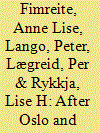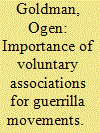|
|
|
Sort Order |
|
|
|
Items / Page
|
|
|
|
|
|
|
| Srl | Item |
| 1 |
ID:
123956


|
|
|
|
|
| Publication |
2013.
|
| Summary/Abstract |
The article addresses the challenges a society faces to when trying to balance security and liberty after a terrorist attack. A main question is to what extent attitudes toward counterterror measures changed in Norway after the massive terror attacks in July 2011. A hypothesis that people will be more in favor of such measures after a terror attack is examined using data from two surveys-one conducted in 2006 and one in August 2011, with additional results from a survey in 2012. The Norwegian response after the 2011 attacks is compared to the response to the same questions in the United States shortly after 11 September 2001. A main finding is that in Norway, in contrast to the United States, levels of support for counterterror measures declined immediately after the attacks. The authors argue that this can be explained partly by the different levels of trust in the two countries, and partly by differences in the political executive's framing of the crisis. In 2012, support of counterterror measures in Norway has risen to pre-2011 levels. This is related to the changed discourse after the publication of the report from the 22 July Commission.
|
|
|
|
|
|
|
|
|
|
|
|
|
|
|
|
| 2 |
ID:
123954


|
|
|
|
|
| Publication |
2013.
|
| Summary/Abstract |
The question I examine in this article is why is it that under certain circumstances a guerrilla movement succeeds while under others it fails? The hypotheses that I shall present below are the greater the number and variety of voluntary associations supporting the guerrilla movement, compared with the number of associations supporting the regime, the greater is the guerillas' level of success. Voluntary associations can fulfill the guerrilla's basic needs: resources, organizational ability, and obligation. Achieving these needs assist the guerrilla in realizing: population support; inter-class allies; military force; governmental function, which in turn allows the realization of the political objectives.
|
|
|
|
|
|
|
|
|
|
|
|
|
|
|
|
| 3 |
ID:
123955


|
|
|
|
|
| Publication |
2013.
|
| Summary/Abstract |
A hallmark of the resurgence of antigovernment forces in Afghanistan was the mass introduction of suicide terrorist attacks. Between 2005 and 2006, the incidence of suicide bombings increased more than fivefold, marking a sea change in the Afghan conflict. Despite the initial jump in the volume of suicide attacks and the fear of more violence, the number of attacks actually flat-lined while the level of other attacks increased. This study will argue that it is the competency of the attackers employed in Afghanistan, not the politics, technology, or targeting, that best explains the static level of suicide attacks.
|
|
|
|
|
|
|
|
|
|
|
|
|
|
|
|
| 4 |
ID:
123957


|
|
|
|
|
| Publication |
2013.
|
| Summary/Abstract |
Given its religious demography, sub-Saharan Africa seems particularly prone to the outbreak of violent clashes between Christians and Muslims. This article compares three sub-Saharan countries-Nigeria, Côte d'Ivoire, and Tanzania-that display different levels of inter-religious violence despite each having in common similar population ratios of Christians and Muslims, as well as all sharing a number of the classical risk factors for conflict onset. The analysis of these three case studies shows that higher levels of inter-religious violence result from horizontal inequalities and overlapping religious and ethnic group boundaries that, in the context of tense political transformation, consequently breed inter-religious grievances and violence. When theological ideas become politicized, inter-religious violence reaches its most intense level of expression.
|
|
|
|
|
|
|
|
|
|
|
|
|
|
|
|
|
|
|
|
|